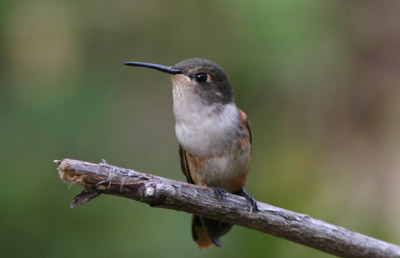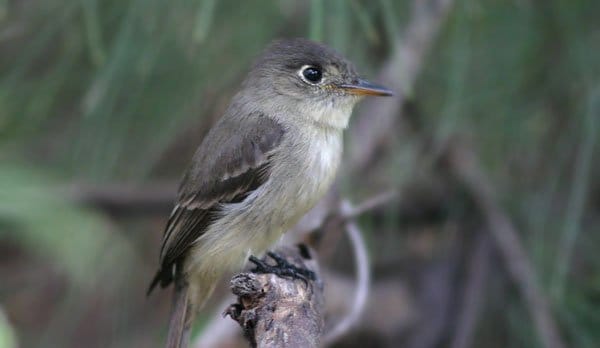Though we had observed most of Paradise Island’s avifauna the previous day, we got great follow-up views as our trip progressed. The predominant gull we saw was Laughing, mixed in with a handful of Herring and Ring-billed. The prevalent raptor was American Kestrel, the Bahamian race possessed of a pure white belly. Collared doves and, to a lesser degree, Rock Pigeons were everywhere, but we also observed plenty of Common Ground Dove, diminutive in comparison with other pigeons.

Bahama Woodstar
Our Sunday morning mission was to walk into downtown Nassau for some decent coffee (Starbucks instead of instant!) and then hit the Botanical Gardens. Unfortunately, our taxi pulled up to a barred garden gate. Plan B was the Ardastra Zoo and Gardens, easily the low point of our trip. As someone who prefers his wildlife wild, the sight of imprisoned parrots, reptiles, and mammals was impossible to enjoy. Ardastra does promote conservation, particularly of the Caribbean Flamingo. It also houses some animals that have been rehabilitated but deemed unable to return to the wild. Nonetheless, it wasn’t our cup of tea. Apart from the array of exhibited exotics, the most interesting bird was a Black-and-white Warbler plundering an empty cage.
Carolyn had mentioned that the Lakeview Drive ponds held an exciting visitor blown into the Bahamas by a recent hurricane. Though I missed the Anhinga on my previous visits, I spotted it Sunday afternoon, along with Osprey, Green Heron, and Northern Waterthrush. We also found our first Blue-winged Teal there.
Monday was a travel day, which in these troubled times means getting to the airport three hours early for a flight that leaves an hour late. Nonetheless, we had a bit of time in the morning to check the Lakeview ponds and enjoy our last taste of spring weather before returning to our New York winter. We spotted more of the same delightful birds, with the addition of Tricolored Heron and Yellow-throated Warbler. The fun didn’t really start though until Sara returned to our room to pack. I was taking some final photographs of these amazing Caribbean birds when I spotted one final surprise. There, hiding in a bush behind our hotel, was old crescent-eye itself, the Cuban Pewee, one of my target life birds and the last new species for the trip.
The resort lifestyle is most certainly not our bag. However, Paradise Island and New Providence offers an excellent array of avifauna, enough to satisfy adventurous birders for a weekend. After more than a couple of days, though, one would do well to consider visiting some of the other islands in search of other endemics and specialties.














I’d like help in identifying a bird. We live on Culberts Point, The most Eastern point of New Providence. We sometimes see an unusual looking bird HOVERING high above the vacant lot next door, looking like a flying cross. It seems dark brown. It then banks sharply and disappears.
I once saw from our balcony what I think is the same sort of bird, perched on a high tree branch. It seemed to have large “owl eye” markngs on the BACK of its head, a rather parrot like beak and very big feet. The only references I can find for hovering would be a kestrel or an osprey. but nothing mentions the owl eye like markings wbhich are VERY distinctive, at least in my memory.
I will try to get a photo.
Thanks,
Sara Parker 324-1457